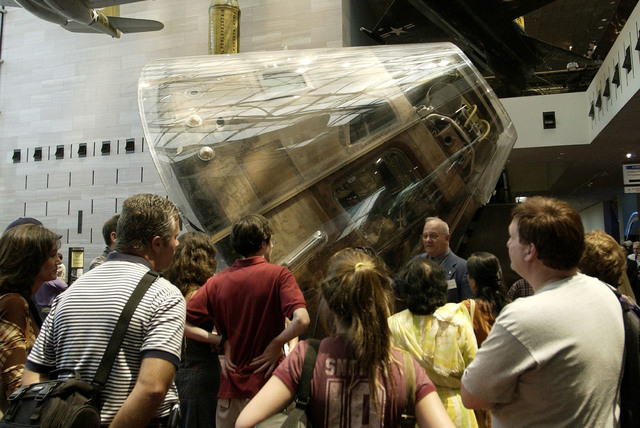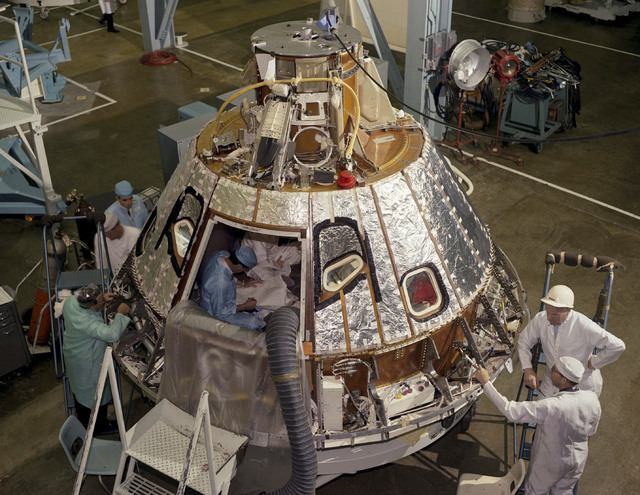Apollo 11 capsule to go on 4-city tour


CHANTILLY, Va. — The Apollo 11 command module, which traveled more than 950,000 miles to take Americans to the moon and back in 1969, is going on a road trip, leaving the Smithsonian for the first time in more than four decades.
The capsule, named “Columbia,” went on a tour of U.S. capitals following its historic role in the mission to the moon. But it has since made its home at the Smithsonian in Washington. On Wednesday, officials announced a four-city road tour ahead of the 50th anniversary of the moon landing in 2019. The capsule will visit museums in Houston, St. Louis, Pittsburgh and Seattle as part of a new exhibit: “Destination Moon: The Apollo 11 Mission.”
Part of the reason for the tour is that the Smithsonian is working to renovate the gallery at its National Air and Space Museum in Washington that tells the story of the Apollo missions, but that exhibit isn’t scheduled to open until 2020. Smithsonian space history department curator Allan Needell says the Smithsonian didn’t want to just store the capsule and instead decided that “while we’re preparing for its new home we could share it with other venues and have some broader access to it.”
The command module is only a part of the spacecraft that blasted off from NASA’s Kennedy Space Center in Florida, on July 16, 1969, on an eight-day moon mission. The capsule, its interior about the size of a car, was the main work and living area for the three-man crew. And it was the craft astronaut Michael Collins piloted while his crewmates, astronauts Neil Armstrong and Buzz Aldrin, descended to the moon’s surface in the Lunar Module “Eagle.”
The command module was the only part of the spacecraft to return to Earth, however, and that made it an object of fascination. More than 3 million people saw it and an accompanying moon rock during a tour of U.S. state capitals in 1970 and 1971. Americans often waited hours to get inside a trailer that housed the capsule during its tour. The capsule visited every state and missed only one state capital, visiting Anchorage in Alaska rather than Juneau, before it was transferred to the Smithsonian.
The Apollo 11 capsule is currently being readied for its trip at the Smithsonian’s Steven F. Udvar-Hazy Center in Chantilly, Virginia. Conservators are giving the capsule a full checkup — examining and documenting its condition before it goes on tour. One concern for Smithsonian conservator Lisa Young is the condition of the spacecraft’s heat shield, which was designed to take a beating on its re-entry to Earth’s atmosphere. Layers of the heat shield were designed to burn away when the craft re-entered the atmosphere and what remains will need to be stabilized before the capsule goes traveling.
Visitors who go to see the capsule on tour will also get to see other objects that were used on the lunar mission, including gloves and a visor Aldrin wore on the moon and a “rock box” used to bring back the first samples of the moon. They’ll also be able to explore an interactive, 3D tour of the inside and outside of the capsule.
Curators think of the tour as a preview of that exhibit that will open back at the Smithsonian in 2020 and replace a moon exhibit that opened with the museum in 1976.
The capsule will begin its tour in Houston in October of this year and spend about five months at each site, ending in Seattle where it will be for the 50th anniversary of the moon landing: July 20, 2019. The capsule also will visit: the Space Center Houston from Oct. 14, 2017, to March 18, 2018; the Saint Louis Science Center from April 14 to Sept. 3, 2018; the Senator John Heinz History Center in Pittsburgh from Sept. 29, 2018, to Feb. 18, 2019; and The Museum of Flight in Seattle from March 16 to Sept. 2, 2019.
RELATED
Scientists say Earth’s moon 4.51B years old












